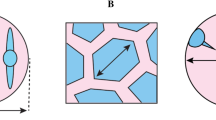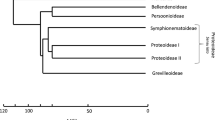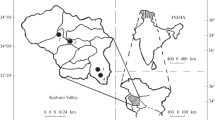Abstract
Pollen morphology can be useful in the determination of phylogeny and mating systems of plants. Pollen ovule ratios can give an indication of the mating system of plant species, and there are a number of theories as to reductions in response to pollination strategies. Pollen tetrad segregation occurs when a number of pollen grains within a tetrad abort; this process has evolved a number of times in the family Ericaceae. Pollen ovule ratios along with the total number of tetrads, number of viable grains and proportions of each of the tetrad types were investigated in six species of Acrotriche (Styphelioideae: Ericaceae). Pollen ovule ratios were used in comparison with related species to give indications of mating systems and to examine theories regarding reductions in pollen production. The study species can be arranged into distinct groupings based on the proportions of tetrad types that correlate with floral morphology and may be indicative of phylogentic associations.


Similar content being viewed by others
References
Burd M, Ashman T-L, Campbell DR, Dudash MR, Johnston MO, Knight TM, Mazer SJ, Mitchell RJ, Steets JA, Vamosi JC (2009) Ovule number per flower in a world of unpredictable pollination. Am J Bot 96(6):1159–1167. doi:10.3732/ajb.0800183
Celebrezze T, Paton DC (2004) Do introduced honeybees (Apis mellifera, Hymenoptera) provide full pollination service to bird-adapted Australian plants with small flowers? An experimental study of Brachyloma ericoides (Epacridaceae). Austral Ecol 29(2):129–136
Chouteau M, Barabé D, Gibernau M (2006) Pollen-ovule ratios in some Neotropical Araceae and their putative significance. Plant Syst Evol 257(3):147–157
Crayn DM, Quinn CJ (2000) The evolution of the atp beta-rbcL intergenic spacer in the epacrids (Ericales) and its systematic and evolutionary implications. Mol Phylogenet Evol 16(2):238–252
Cruden R (1977) Pollen-ovule ratios: a conservative indicator of breeding systems in flowering plants. Evolution 31(1):32–46
Cruden RW (2000) Pollen grains: why so many? Plant Syst Evol 222(1):143–165
Franks W, Watson J (1963) The pollen morphology of some critical Ericales. Pollen Spores 5:51–68
Furness CA (2009) Pollen evolution and development in Ericaceae, with particular reference to pseudomonads and variable pollen sterility in Styphelioideae. Int J Plant Sci 170(4):476–495. doi:10.1086/597268
Furness C, Rudall P (2011) Selective microspore abortion correlated with aneuploidy: an indication of meiotic drive. Sex Plant Reprod. doi:10.1007/s00497-010-0150-z
Galloni M, Podda L, Vivarelli D, Cristofolini G (2007) Pollen presentation, pollen-ovule ratios, and other reproductive traits in Mediterranean legumes (Fam. Fabaceae - Subfam. Faboideae). Plant Syst Evol 266(3):147–164
Harder D, Johnson D (2008) Function and evolution of aggregated pollen in angiosperms. Int J Plant Sci 169(1):59–78. doi:10.1086/523364
Hislop M (2007) A new species and a new combination in Acrotriche (Ericaceae: Styphelioideae: Styphelieae), with keys to the Western Australian members of the genus and its closest relative Lissanthe. Nutysia 16(2):285–297
Hislop M (2010) A new locally endemic species of Acrotriche (Ericaceae: Styphelioideae: Styphelieae) from the Ravensthorpe area. Nuytsia 20:19–25
Howell G, Slater A, Knox R (1993) Secondary pollen presentation in angiosperms and its biological significance. Aust J Bot 41(5):417–438. doi:10.1071/BT9930417
Kron KA, Judd WS, Stevens PF, Crayn DM, Anderberg AA, Gadek PA, Quinn CJ, Luteyn JL (2002) Phylogenetic classification of Ericaceae: molecular and morphological evidence. Bot Rev 68(3):335–423
Ladd PG (1994) Pollen presenters in the flowering plants—form and function. Bot J Linn Soc 115:165–195
McConchie CA, Hough T, Singh MB, Knox RB (1986) Pollen presentation on petal combs in the geoflorous heath Acrotriche serrulata (Epacridaceae). Ann Bot 57:155–164
McGlone M (1978) Pollen structure of the New Zealand members of the Styphelieae (Epacridaceae). N Z J Bot 16:91–101
Ooi M (2002) Fire response and seedling emergence patterns in Leucopogon (Epacridaceae) in South-Eastern Australia. Master's Thesis, University of Wollongong, Wollongong
Pacini E, Hesse M (2004) Cytophysiology of pollen presentation and dispersal. Flora 199(4):273–285
Paterson B (1962) Systematic studies of the anatomy of the genus Acrotriche R.Br. 2. The flower. Aust J Bot 10(1):55–64. doi:10.1071/BT9620055
PlantNET (2010) National Herbarium of New South Wales. http://plantnet.rbgsyd.nsw.gov.au/. Accessed 29 July 2010
Quinn CJ, Crayn DM, Heslewood MM, Brown EA, Gadek PA (2003) A molecular estimate of the phylogeny of Styphelieae (Ericaceae). Aust Syst Bot 16(5):581–594. doi:10.1071/sb03012
Quinn CJ, Brown EA, Heslewood MM, Crayn DM (2005) Generic concepts in Styphelieae (Ericaceae): the Cyathodes group. Aust Syst Bot 18(5):439–454. doi:10.1071/SB05005
Schneemilch M, Steggles E (2010) The mating system of Acrotriche serrulata (Ericaceae). Aust J Bot 58:124–132
Schneemilch M, Williams C, Kokkinn M (2011) Floral visitation in the Australian native shrub genus Acrotriche R.Br (Ericaceae): and abundance of ants (Formicidae). Aust J Entomol (in press)
Smith-White S (1948) A survey of chromosome numbers in the Epacridaceae. Proc Linn Soc NSW 73:37–56
Smith-White S (1955) Chromosome numbers and pollen types in the Epacridaceae. Aust J Bot 3(1):48–67. doi:10.1071/BT9550048
Smith-White S (1959a) Pollen development patterns in the Epacridaceae: a problem in cytoplasm-nucleus interaction. Proc Linn Soc NSW 84:8–35
Smith-White S (1959b) Pollen tetrad segregation in Astroloma pinifolium and in Acrotriche fasciculiflora. Bot J Linn Soc 84:259–270
Smith-White S (1963) Variable tetrad pollen in Astroloma from southern Australia. Proc Linnean Soc NSW 88:91–102
Venkata Rao C (1961) Pollen types in the Epacridaceae. J Indian Bot Soc 40:409–423
Walker J (1971) Pollen morphology, phytogeography, and phylogeny of the Annonaceae. Contr Gray Herb Harvard 202:1–132
Wyatt R, Broyles SB, Lipow SR (2000) Pollen-ovule ratios in milkweeds (Asclepiadaceae): an exception that probes the rule. Syst Bot 25(2):171–180. doi:10.2307/2666636
Yeo P (1993) Secondary pollen presentation: form, function and evolution. Springer, Vienna
Acknowledgments
Many thanks to Dr. Leanne Powell for editing assistance.
Author information
Authors and Affiliations
Corresponding author
Rights and permissions
About this article
Cite this article
Schneemilch, M., Kokkinn, M. Pollen tetrad segregation and pollen ovule ratios in six species of Acrotriche (Styphelioideae: Ericaceae). Plant Syst Evol 296, 149–156 (2011). https://doi.org/10.1007/s00606-011-0451-1
Received:
Accepted:
Published:
Issue Date:
DOI: https://doi.org/10.1007/s00606-011-0451-1




